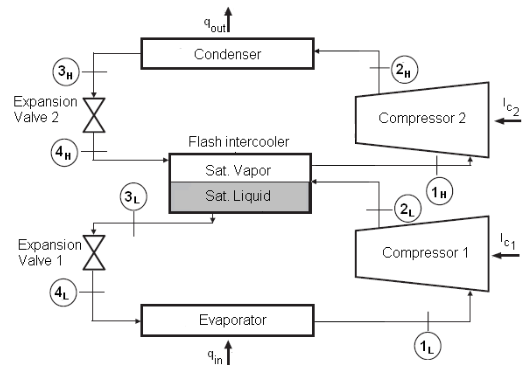Introduction
Dual-stage refrigeration circuits are advanced cooling systems specifically designed to meet the complex demands of industries requiring extremely low temperatures and highly efficient refrigeration solutions. These circuits are built upon a multi-stage design where two refrigeration cycles operate in tandem, often in a cascade configuration, to achieve higher levels of cooling performance compared to traditional single-stage systems. The unique advantage of dual-stage systems lies in their ability to handle a broader range of temperatures—usually with the first stage designed to handle medium temperatures and the second stage optimized for subzero or cryogenic conditions.
These systems are widely employed in industries like pharmaceuticals, food preservation, cryogenics, and medical refrigeration, where precise temperature control and energy efficiency are critical. In these applications, a dual-stage refrigeration circuit is not only about providing cooling but also about doing so with enhanced energy conservation, cost-efficiency, and minimized environmental impact. By integrating two stages, each operating at different pressures and temperatures, the system maximizes the thermodynamic efficiency, making it possible to achieve low temperatures more effectively and reduce the overall operating cost.
Key Components of Dual-Stage Refrigeration Circuits
- Compressor
The compressor is the heart of a refrigeration circuit. In a dual-stage system, it is divided into two stages. The first compressor operates at a higher temperature range, while the second one is responsible for compressing the refrigerant from the first stage to an even lower temperature. These compressors are often specially designed for the required pressures and cooling capacities. - Evaporators
Each stage in a dual-stage refrigeration circuit has its own evaporator, where the refrigerant absorbs heat from the surroundings. The evaporators operate at different temperatures, with the first evaporator typically handling higher temperatures and the second designed for lower temperatures. This allows the system to achieve better overall efficiency in cooling. - Condenser
The condenser works by releasing the absorbed heat from the refrigerant. In dual-stage systems, two condensers are used: one for each stage. The first-stage condenser releases heat at a higher temperature, while the second-stage condenser releases heat at a much lower temperature, optimizing energy use and heat dissipation. - Expansion Valves
Expansion valves control the flow of refrigerant into the evaporators. In a dual-stage system, the valves regulate the refrigerant’s pressure as it enters each stage of the cycle. The first expansion valve manages the refrigerant entering the first evaporator, while the second expansion valve controls the refrigerant flow into the second stage. - Refrigerants
Different refrigerants are typically used in each stage to optimize the system’s performance. The refrigerant in the first stage is usually selected for its effectiveness in higher temperature ranges, while the second stage uses a refrigerant suitable for low-temperature operations. Common refrigerants include R-134a, R-404A for the first stage, and R-23, R-14 for the second.
Benefits of Dual-Stage Refrigeration Circuits
- Enhanced Cooling Efficiency
By using two stages to handle different temperature ranges, dual-stage refrigeration circuits can achieve more efficient cooling than single-stage systems. The cascade method allows the system to maintain low temperatures more effectively, making it ideal for cryogenic applications and industries that require precision cooling. - Energy Savings
Dual-stage systems can operate more efficiently because each compressor is optimized for specific temperature ranges. This results in lower energy consumption compared to a single-stage system, which may require more power to maintain similar performance at lower temperatures. - Improved Temperature Control
Dual-stage systems offer better control over temperature, particularly in processes requiring extreme low temperatures. The cascading effect of the two stages allows for more precise regulation of temperatures, which is critical in applications like freeze-drying, medical storage, and industrial refrigeration. - Extended Equipment Life
Because dual-stage systems are more efficient and operate at optimized pressures and temperatures, the wear and tear on the compressors and other components is reduced. This results in a longer lifespan for the equipment, making it a cost-effective investment for industries with high refrigeration demands. - Flexibility in Application
Dual-stage refrigeration circuits can be tailored to a wide variety of applications, from industrial cooling systems to laboratory and medical refrigeration. This adaptability allows the system to meet the specific requirements of industries that need precise and reliable cooling solutions.
Challenges of Dual-Stage Refrigeration Circuits
- Complexity in Design and Maintenance
Dual-stage refrigeration circuits are more complex than single-stage systems, requiring careful design and installation. This complexity can also make maintenance more challenging, as it requires expertise in handling multiple stages, refrigerants, and components. - Higher Initial Costs
The design and construction of dual-stage refrigeration systems can be more expensive due to the additional components, such as compressors, evaporators, and condensers. However, the long-term energy savings and improved performance often justify the initial investment. - Space Requirements
Dual-stage systems, with their multiple compressors, evaporators, and condensers, typically require more space than single-stage systems. This can be a concern in applications where space is limited, such as small industrial facilities or laboratories.
Conclusion
Dual-stage refrigeration circuits represent a cutting-edge solution for industries that demand precise temperature regulation, superior cooling efficiency, and energy savings. By utilizing a two-stage cooling process, these systems provide enhanced performance in high-demand applications, such as pharmaceuticals, food processing, cryogenics, and laboratory environments. The key benefits, such as improved heat transfer efficiency, lower energy consumption, and extended equipment lifespan, make dual-stage systems an invaluable investment for industries aiming to optimize operational efficiency while minimizing environmental impact.
However, the complexity, higher initial costs, and space requirements must be considered when adopting these systems, making the design and maintenance more demanding. Despite these challenges, the long-term advantages in terms of energy savings, operational reliability, and the ability to meet stringent cooling requirements make dual-stage refrigeration circuits a highly favorable option for modern industrial applications.

